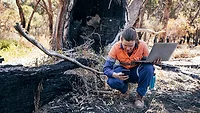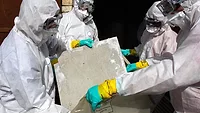Handling Hazards
Environmental hazards like asbestos, PCBs and lead can change the complexion of a seemingly routine job.
It’s a typical day of restoration work for you and your work crews - a small water damage job in an office complex basement, a smoke-damaged kitchen in a high school and a vandalism clean-up at a former plastics company building downtown. You have sent crews out to each of the project sites to assess the damages and start the necessary clean-up/rehabilitation process. You are also hoping it will be a quiet day.
That’s when you receive a call from the water damage crew, “Hey, I think we have some asbestos floor tile in this basement.” You get in your truck and head over to the office complex and discover that those dark green floor tiles hidden under the carpet are in fact 9-inch floor tiles, but are they asbestos-containing tiles?
Before you get that question answered, the smoke damage crew calls in saying, “We started cleaning these walls in the high school kitchen and the paint is starting to peel off and fall all over the floor. We think that it might be lead-based paint, but we have no paperwork that verifies this.”
Now your day has gone from simple to complex and it’s getting worse by the minute as the vandalism clean-up crew calls you and says that vandals stole some copper wiring and broke open a big transformer in the basement of the plastics building. The transformer is leaking a yellow-colored oil and the side of the transformer has a yellow tag that reads, “Caution: Contains PCBs.” The worker on the phone asks “What are PCBs and what should we do now?”
A relatively ordinary day of restoration work has suddenly turned and now you have three possible environmental hazards to deal with. What does asbestos, lead-based paint and PCBs mean to you and your employees? The following information provides background and an explanation of each hazard:
Asbestos
Asbestos is a naturally occurring mineral that has been used since the time of the Romans and Greeks. The material’s ability to resist extremely high temperatures and still be woven into cloth made it an optimal material for many things such as lamp wicks, table cloths and burial shrouds. Jump ahead to the 1930’s, when asbestos could be economically mined and processed into a durable material that was used in thousands of industrial, commercial and residential products including fireproofing, plasters, pipe insulations and many other applications. Asbestos is extremely thin, lightweight and able to retain high tensile strength, making it a good binding element for many products such as flooring, roofing and caulking. Most importantly, it was cheap and readily available in almost every major country in the world, including the United States. Between the 1930s and the 1980s, asbestos products were used in the construction of almost every building in the U.S.
If asbestos was so great, why is it such a hazard? Simply put, if asbestos-containing materials are damaged or handled improperly, they produce airborne fibers as small as 0.5 microns (the average human hair is 75 microns across) which are easily inhaled. Once inhaled into the lungs, the asbestos fibers pierce the soft lining of the lung tissue and become embedded. The human body has no way to digest or expel the fibers from the lungs, so the body surrounds the fiber creating scar tissue. This scar tissue can eventually (typically 20-30 years later) lead to irreparable lung damage and/or cancer. Additionally, these needle-like fibers can push all the way through the lungs and into the pleura (the sack that surrounds the lungs) causing a malignant cancer called “mesothelioma.”1
Lead
Lead is a naturally occurring element (Pb, No. 82 on the periodic table) that has been used in some fashion or another since around 3500 BC2. Ancient Romans used lead to make plumbing pipes, glass, cisterns, bathtubs and repairs of other metal items. Lead was readily used because it was easily mined, could be worked with using simple tools or hand force and had a relatively low melting point. Lead’s true potential wasn’t entirely achieved until the industrial and chemical age when it was discovered that the element could be used as an invaluable additive in materials, including leaded gasoline, glazing on ceramics and, most notably, paints of all varieties. Lead was added to paints to help them bond better, dry smoother with less bubbling and resist fading and discoloration from sunlight.
Lead-based paints (LBPs) were used for decades in both commercial and residential settings before lead was discovered to be a neurological toxin, especially in babies and young children. Due to the toxic nature of lead, it affects the body systemically by poisoning the kidneys, arteries and blood vessels, the digestive tract and, most commonly, the brain and central nervous system. In young children, lead exposure can cause lower IQ, slowed growth rates, behavioral problems or even loss of hearing. In pregnant women, high blood-lead levels can travel from mother to child, which can cause birth defects and premature birth.
As with asbestos, dust contaminated with lead can be transported home from a job site on the clothes of a worker and family members can be exposed to these hazards.
PCBs
While asbestos and LBP are well-known as health hazards and were used extensively for decades, what are PCBs? Polychlorinated biphenyls (PCBs) were generally manufactured under the trade name Aroclor3and are a mixture of synthetic and organic chemicals. PCBs are usually a translucent-to-yellow colored oil or waxy material used in the production of certain electrical equipment because of their high boiling point, chemical stability and high electrical resistivity.
PCBs are often found in the ballasts of lighting fixtures, transformers and various other electrical components manufactured from the 1930s to the 1970s. Within recent years, the Environmental Protection Agency (EPA) has determined that numerous schools and public buildings constructed or renovated from the 1950s to the 1970s utilized caulking that also contained PCBs. Like asbestos and lead, PCBs can be extremely hazardous to humans. Repeated skin exposure can lead to skin irritation and a severe form of dermatitis called “chloracne.” Prolonged exposure to the chemical can also cause systematic damage to the body’s immune, reproductive, central nervous and endocrine systems.
Back to the challenging day of restoration work - now that you and your crews have uncovered some serious environmental hazards, how do you respond to them? The simple answer: talk with a qualified environmental consultant, whose main job and concern is to protect the health and safety of you, your employees, the general public and the environment. Having a good environmental consultant on standby will help limit health and safety risks to your employees and limit potentially severe financial risk to your company.
Environmental consultants take samples of suspect asbestos, LBP and PCBs for laboratory analysis to identify if they contain hazardous materials. After tests are run on the substance, the consultant presents analytical results in a final report of their findings, while also suggesting professional recommendations for corrective or remediation actions. The consultant can also provide you with a list of recommended contractors to properly handle and dispose of the materials, if applicable. This process would help resolve all three hazardous materials scenarios previously outlined.
An environmental consultant can also answer other questions, while helping you develop a plan to move forward addressing the challenge at hand within a short time frame. The consultant will help you protect your company and keep your sanity intact by explaining regulations, outlining available options and presenting solutions to your project challenges.
Asbestos, lead, PCBs, and other hazardous materials are commonly found in buildings and building materials. While you hope for the best on a project, you should also plan for these challenges in advance so that you can minimize risk, preserve your budget, and maintain your schedule. Having an “on-call” environmental consultant will help you be proactive and ready for the project challenge when it arises.
Looking for a reprint of this article?
From high-res PDFs to custom plaques, order your copy today!








